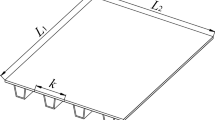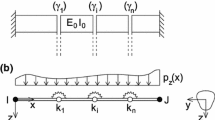Abstract
This paper shows a more exact and practical finite element model of the steel girder deck pavement. Based on Mindlin thick plate theory, a 12-node solid thick plate element was constituted to analyze the pavement. The computation result was compared with that by traditional 4-node and 8-node thick plate finite element, and is satisfactory. A combined plate beam element method is presented to investigate the stiffened plate. A 6-node solid thin plate element was constituted to analyze the top plate based on Kirchhoff thin plate theory. The stiffeners acting as the vertical supporting function mainly are taken as Euler beam elements. A method of using the linear interpolation to realize the longitudinal displacement and the cubic Hermite interpolation to the vertical displacement is presented to analyze the stiffeners. In addition, it is essential to consider the displacement coordination between the top plate and stiffeners. A node-to-node contact scheme, which is applicable for three-dimensional contact analyses involving large deformations, was used to treat the contact problem between pavement and stiffened plate by Lagrange multiplier methods.
Similar content being viewed by others
References
C. T. Metcalf, Flexural tests of paving materials for orthotropic steel plate bridges, Highway Research Record, 155 (1967) 56–78.
M. S. G. Cullimore, I. D. Flett and J. W. Smith, Flexure of steel bridge deck plate with asphalt surfacing, IABSE Periodical, Bristol: University of Bristol, 1 (1983) 58–83.
Koroneose, Oscillations measurements of an orthotropic roadway deck with bituminous cover, Bitumen Teere Asphalt Peche, 5 (1971) 223–236.
M. H. Kolstein and J. H. Dijkink, Behavior of modified bituminous surfacing on orthotropic steel bridge decks, Proceedings of the 4th Euro-bitumen Symposium, 1 (1989) 907–975.
M. H. Kolstein and J. Wardenier, Stress reduction due to surfacing on orthotropic steel decks, Proceedings of the ISAB Workshop: Evaluation of Existing Steel and Composite Bridges (1997).
G. H. Gunther, S. Bild and G. Sedlacek, Durability of asphaltic pavements on orthotropic decks of steel bridges, Construct Steel Research, 7 (1987) 5–106.
S. Bild, Durability design criteria for bituminous pavements on orthotropic steel bridge decks, Can. J. Civ. Eng., 14 (1) (1987) 41–48.
H. Nakanishi and T. Okochi, The structural evaluation for an asphalt pavement, AAPA (2000) 113–123.
T. Nishizawa, K. Himeno, K. Nomura and K. Uchida, Development of a new structural model with prism and strip elements for pavement on steel bridge decks, The International J. of Geomechanics, 1 (3) (2001) 351–369.
R. Szilard, Theories and applications of plate analysis, Hoboken, New Jersey, USA: John Wiley&Sons (2004).
E. Reissner, The effect of transverse shear deformation on the bending of elastic plate, Transactions of ASME J. Applied Mechanics, 12 (1945) A69–A77.
R. D. Mindlin, Influence of rotary inertia and shear on flexural motions of isotropic elastic plates, J. of Applied Mechanics, 18 (1) (1951) 31–38.
C. Y. Chia, Non-linear analysis of plates, McGraw-Hill, New York (1980).
I. Senjanovc, N. Vladimir and D. S. Cho, A new finite element formulation for vibration analysis of thick plates, Int. J. Nav. Archit. Ocean Eng., 7 (2015) 324–345.
T. J. R. Hughes, R. L. Taylor and W. Kanoknukulchai, Simple and efficient element for plate bending, International J. for Numerical Methods in Engineering, 11 (10) (1977) 1529–1543.
C. Lovadina, Analysis of a mixed finite element method for the Reissner-Mindlin plate problems, Computer Methods in Applied Mechanics and Engineering, 163 (1998) 71–85.
O. C. Zienkiewicz and R. L. Taylor, The finite element method, 5th ed., Oxford: Butterworth-Heinemann (2000).
K. Bletzinger, M. Bischoff and E. Ramm, A unified approach for shear-locking-free triangular and rectangular shell finite elements, Computers and Structures, 75 (3) (2000) 321–334.
H. Nguyen-Xuan, G. R. Liu, C. Thai-Hoang and T. Nguyen-Thoi, An Edge-based smoothed Finite element method (ES-FEM) with stabilized discrete shear gap technique for analysis of Reissner-Mindlin plates, Computer Methods in Applied Mechanics and Engineering, 199 (9–12) (2010) 471–489.
P. Wriggers, Computational contact mechanics, Springer, New York (2007).
P. Wriggers and J. C. Simo, A note on tangent stiffness for fully nonlinear contact problems, Comp. Appl. Num. Meth., 1 (1985) 199–203.
J. T. Oden, Exterior penalty methods for contact problems in elasticity, Wunderlich KJBW, E. Stein (ed), Nonlinear Finite Element Analysis in Structural Mechanics, Springer, Berlin (1981).
S. Jin, D. Sohn and S. Im, Node-to-node scheme for threedimensional contact mechanics using polyhedral type variable-node elements, Comput. Methods Appl. Mech. Engrg., 304 (2016) 217–242.
G. Pietrzak, Continuum mechanics modelling and augmented lagrange formulation of large deformation frictional contact problems, Technical Report 1656, Ecole polytechnique federale de Lausanne, EPFL (1997).
A. R. Mijar and J. S. Arora, An augmented Lagrangian optimization method for contact analysis problems, 2: Numerical evaluation, Struct. Multidiscip. Optim., 28 (2004) 113–126.
M. Chandrashekhar and R. Ganguli, Large deformation dynamic finite element analysis of delaminated composite plates using contact-impact conditions, Computers and Structures, 144 (2016) 92–102.
A. P. C. Dias, A. L. Serpa and M. L. Bittencourt, Highorder mortar-based element applied to nonlinear analysis of structural contact mechanics, Comput. Methods Appl. Mech. Engrg., 294 (2015) 19–55.
C. J. Corbett and R. A. Sauer, Three-dimensional isogeometrically enriched finite elements for frictional contact and mixed-mode debonding, Comput. Methods Appl. Mech. Engrg., 284 (2015) 781–806.
Y.-W. Kim, Finite element formulation for earthquake analysis of single-span beams involving forced deformation caused by multi-support motions, J. of Mechanical Science and Technology, 29 (2) (2015) 461–469.
Y.-J. Kee and S.-J. Shin, Structural dynamic modeling for rotating blades using three dimensional finite elements, J. of Mechanical Science and Technology, 29 (4) (2015) 1607–1618.
J. Yang, Y. Lei, J. Han and S. Meng, Enriched finite element method for three-dimensional viscoelastic interface crack problems, J. of Mechanical Science and Technology, 30 (2) (2016) 771–782.
W. A. Siswanto, M. Nagentrau, A. L. Mohd Tobi and M. N. Tamin, Prediction of plastic deformation under contact condition by quasi-static and dynamic simulations using explicit finite element analysis, J. of Mechanical Science and Technology, 30 (11) (2016) 5093–5101.
D.-K. Shin, Verification of the performance of rotatable jig for a single cantilever beam method using the finite element analysis, J. of Mechanical Science and Technology, 31 (2) (2017) 777–784.
Author information
Authors and Affiliations
Corresponding author
Additional information
Recommended by Associate Editor Choon Yeol Lee
Wenhuo Sun is a doctoral candidate in Bridge and Tunnel Engineering at South China University of Technology, China. His current research area is mainly on the nonlinear dynamics analysis of the steel girder deck pavement using analytical method.
Rights and permissions
About this article
Cite this article
Sun, W., Gu, L., Wang, R. et al. Adaptive finite element analysis of steel girder deck pavement. J Mech Sci Technol 32, 593–603 (2018). https://doi.org/10.1007/s12206-018-0106-4
Received:
Revised:
Accepted:
Published:
Issue Date:
DOI: https://doi.org/10.1007/s12206-018-0106-4




